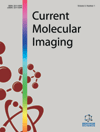- Home
- A-Z Publications
- Current Molecular Imaging (Discontinued)
- Previous Issues
- Volume 3, Issue 1, 2014
Current Molecular Imaging (Discontinued) - Volume 3, Issue 1, 2014
Volume 3, Issue 1, 2014
-
-
Brain MRI, SPECT and PET in Early Alzheimer’s Disease: A Minor Mismatch between Volumetric and Functional Findings
More LessBackground: Limited data are available in the literature comparing brain SPECT, PET and volumetric MRI in the same cohort of patients with Alzheimer’s disease. Objectives: The main goal was to show a correlation between two different functional imaging substrates, as determined by FDG-PET and SPECT, with structural MRI findings as defined by voxel-based volumetric measurements (VBM), in the same cohort of pati Read More
-
-
-
Correlation between Changes of FDG-PET Findings and those of Mini- Mental Status Examination Scores in Patients with Moderate Alzheimer’s Disease: Usefulness of Stereotactic Extraction Estimation
More LessPurpose: To investigate the association between changes on [18F] fluorodeoxyglucose positron emission tomography (FDG-PET) and clinical deterioration in patients with moderate Alzheimer’s disease (AD), findings of FDG-PET in the first and follow-up stages were compared using stereotactic extraction estimation (SEE) and three-dimensional stereotactic surface projection (3D-SSP). Methods and patients: Thirty co Read More
-
-
-
Molecular Imaging of Neuropsychiatry and Boron Neutron Capture Therapy in Neuro-oncology
More LessAuthors: Chun-Kai Fang, Ya-Fang Chang, Hui-Yen Chuang, Hong-Wen Chen and Jeng-Jong HwangBoth neuropsychiatric disorders and malignancies of central nervous system (CNS) represent a significant health burden and life-threatening diseases worldwide. Radiotracer-based neuroimaging is an attractive tool that permits the in vivo detection and characterization of metabolic and molecular processes which are fundamental elements for brain function, and improves the theranostics of brain diseases and disorders. Read More
-
-
-
Molecular Imaging of Vascular Thrombosis
More LessVascular thrombosis is a crucial event and still cause of significant morbidity and mortality worldwide. Deep vein thrombosis with subsequent pulmonary embolism constitutes a frequent clinical event, while reliable detection, especially of small or old thrombi, still remains clinically challenging. Occlusion or thromboembolism in an arterial vessel may result in myocardial infarction or stroke, and early detection would Read More
-
-
-
The Clinical Usefulness of Nuclear Medicine Techniques in the Diagnosis of Vascular Graft Infections
More LessAuthors: Mauro Liberatore, Valentina Megna, Christos Anagnostou and Francesco Maria DrudiThe infection of a vascular prosthesis (VGI) is the most serious complication in prosthetic vascular reconstructive surgery, burdened by a high rate of mortality and morbidity. The treatment of a VGI, in most cases, consists of its surgical removal, and therefore an accurate diagnosis of the infection, is of paramount importance in clinical practice since false-positive results may lead to unnecessary major surgery whereas fal Read More
-
-
-
Synthesis and Development of MSN-Gd3+-C595 as MR Imaging Contrast Agent for Prostate Cancer Cell Imaging
More LessPurpose: Cell surface antigens as biomarkers suggest high potential for early diagnosis in cancers. The scope of this study is to synthesize Gd3+ based silica nanoparticles that conjugate on monoclonal antibody C595 by a facile method in order to detect human prostate cancer cells. Method: In this study, monoclonal antibody C595, anti-MUC-1, was conjugated on Gd3+-based mesoporous silica nanospheres (MSN-Gd3+-C595) Read More
-
-
-
Annexin A5 Imaging: An Academic Research – Clinical Trials and Theses
More LessAuthors: Tarik Z. Belhocine and Jean-Luc VanderheydenApoptosis or genetically programmed cell death is a universal phenomenon involving many pathophysiological conditions. Externalization of phosphatidylserine from the inner leaflet to the outer leaflet of the cell membrane is an early event in the apoptotic cascade occurring before membrane blebbing and DNA fragmentation. Annexin A5, a 36 kDa endogenous protein, specifically binds to phosphatidylserine with a n Read More
-
-
-
Longitudinal Molecular Imaging of Burn Wound Healing: Effect of Staphylococcus aureus, or Lack of Tumor Necrosis Factor (TNF) or Interleukin-6 (Il-6)
More LessAuthors: Victoria Hamrahi, Walter Jung, John Benjamin and Edward A. CarterBurn wounds become colonized with bacteria during the course of recovery. In addition, there are some burn patients whose wounds do not heal for months. In the present study, we attempted to determine: 1. If seeding of a burn wound with Staphylococcus aureus would affect wound healing: and 2. If knocking out IL-6 and TNF, two cytokines commonly associated with burn injury, would alter burn wound healing. Using Read More
-
Volumes & issues
Most Read This Month
Article
content/journals/cmi
Journal
10
5
false
en


